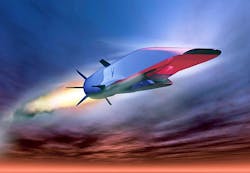Military researchers seek to counter threats from enemy hypersonic missiles and aircraft
Officials of the U.S. Defense Advanced Research Projects Agency (DARPA) in Arlington, Va., issued a broad agency announcement on Tuesday for the Glide Breaker program to counter enemy hypersonic vehicles -- or those that can fly faster than five times the speed of sound.
Top U.S. military leaders over the past year have voiced their alarm about Chinese and Russian projects to develop hypersonic missiles and aircraft. Hypersonic missiles particularly would be useful to attack large U.S. surface warships like aircraft carriers.
The DARPA Glide Breaker project will develop an enabling technology critical for an advanced interceptor capable of defeating hypersonic vehicles, DARPA officials say. Key aspects of the project are classified, and only proposals addressing the classified aspects of Glide Breaker will be eligible for funding.
This effort asks the U.S. defense industry for innovative proposals in counter-hypersonics to advance U.S. means to counter hypersonic vehicles. It will develop and demonstrate an advanced interceptor able to engage enemy maneuvering hypersonic threats in the upper atmosphere.
DARPA officials will choose one contractor for Glide Breaker, which will carry out a system requirements review, preliminary design review, critical design review, and test readiness review to counter enemy hypersonics.
The winning contractor will develop requirements, define a design, manage risk, mature enabling technologies, develop requirements, develop a conceptual design, develop software, conduct trade studies, and analyze costs.
If the Glide Breaker program makes sufficient progress to warrant prototyping and other advanced development, DARPA may release additional solicitations next year.
Companies interested should submit proposals no later than 21 Dec. 2018 to the DARPA BAA Website at https://baa.darpa.mil.
Email questions or concerns to DARPA at [email protected]. More information is online at https://www.fbo.gov/spg/ODA/DARPA/CMO/HR001119S0008/listing.html.
Ready to make a purchase? Search the Military & Aerospace Electronics Buyer's Guide for companies, new products, press releases, and videos
